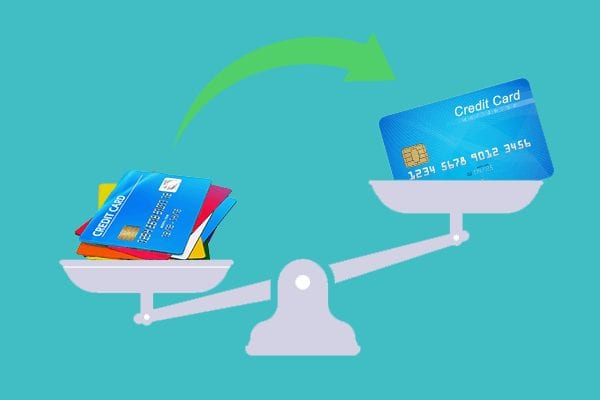Concept of Credit Card Balance Transfer:
Using credit cards to make payments is unquestionably one of the most handy options. Simply pull out your card for every shopping trip, and you’ll be OK even if you don’t have any cash or a readily available debit balance on your account.
However, if you want to emphasise having a solid sense of financial management, you should be aware that credit cards are not the ideal option. When it comes time to pay for the extensive list of costs you accumulated, it may come as a surprise. This is especially important if your credit card has a high monthly interest rate.
A credit card debt transfer might help in this situation. This is a common offer in banks and financial organisations in general.
So, what exactly is a credit card balance transfer, and how can it help you manage your bills and finances? This is what we’ll go through in this essay.

What Is the Process of Credit Card Balance Transfer?
Transferring your present credit debt from one credit card to another is the procedure of credit card balance transfer. It has the same terms and restrictions as any other credit card.
Simply said, a credit balance transfer is one of several options for financial management and debt payback. This will provide you access to better repayment arrangements, such as reduced interest rates and an annual percentage rate. Not only that, but it will allow you to pay lower total costs for your existing loans.

All pending credit payments will be moved to another card if you do a credit card balance transfer.
Assume your present credit card has a 20 percent APR and the loan payback time is around 18 months.
This implies that you will earn around 1.6 percent interest on your spending each month. That same month, your INR 1,000 bill will become INR 1,016. It may not appear to be much, but if we’re talking about the yearly addition, it’ll be INR 192. If you have extra costs to pay during the year, the sum might be considerably greater.
If your expenditures and interest payments become too burdensome, it is certain that you will struggle to meet your monthly credit card obligations.
Click here to check out Credit Calculators.
The credit card balance transfer is now available. Most of the time, the new card involved in the procedure will have a 0% APR. When you move your present sum here, you will receive no interest payments for the length of the transfer. Finally, you will find it easier to repay your debts since you will not have to cope with additional interest payments.
Keep in mind that a balance transfer normally only lasts six to eighteen months. This implies that if you want to get the most out of the procedure, you should make every effort to return your credit debt within the term set.
Another thing to keep in mind is that the credit card balance transfer will only serve as a temporary storage facility for your debt. You cannot use it as another credit card or as a substitute for new payments, whether through a loan or cash. It just serves one purpose: to carry over your existing credit amount from your old credit card.

Is Credit Card Balance Transfer Beneficial for Loan Repayment?
It can undoubtedly assist with loan repayments if you find a reputable financial institution with attractive offers for credit card balance transfers. This is especially true if you’re dealing with a 0% APR for the transfer.
Whether it’s a personal loan or debt from other spending, it will help to alleviate the stress of high APR and interest rates for the time being. Enjoy interest-free repayments and overall cheaper expenditures during the loan term.
What makes a credit card balance transfer even more appealing is that even six months of credit transfer will help you acclimatise to your debts and overall financial management.
What Happens to the Old Credit Card Once the Transfer Is Completed?
After the balance transfer is completed, nothing will happen to your previous credit card. Your bank will not automatically close it unless you request that they do so.
Simply said, you will have complete power over what you do with it, thus you will have the option of closing it or continuing to use it after repaying your loans.
Keep in mind that you will only be able to terminate your previous credit card if there is no pending debt remaining following the transfer. You can also keep using it for new loan payments, but this isn’t feasible if the main goal of credit transfer is to save money.
What Effect Does a Credit Card Balance Transfer Have on Your Credit Score?
Taking out a credit card balance transfer will have no effect on your credit score. It will not give you a lower or better score because it is not a factor of financial achievement.
This isn’t to say that the transfer has nothing to do with your credit score. It can still cause it to rise or fall indirectly. Essentially, how the transfer affects your present credit score is determined on what you do during the procedure.
On the one hand, if you utilise the time to return all of your previous loans, you may anticipate your credit score to improve. In contrast, if you fail to make your monthly loan installments despite the interest-free offer, your credit score would suffer.

Considerations Before Transferring a Credit Card Balance
Even if the advantages and goals of a credit card balance transfer appeal to you based on your current financial situation, you cannot simply apply for the process because you want to.
Instead, you should conduct thorough study and completely comprehend the steps involved in moving your credit amount. This will assist you in avoiding blunders when managing your loan and money.
Is Credit Card Balance Transfer a Good Option for You?
First, determine whether moving your credit card debt to a new card is appropriate for your requirements. Processing the transfer will take a significant amount of time and work on your part. Of course, you will have to pay fees, the amount of which will vary depending on which financial institution you choose to obtain the card.
That being said, you’re correct in believing that the process will improve you. Ask yourself questions like, “Will I be able to pay off my loans by the end of the transfer period?” and “Will the balance transfer offers significantly reduce my loan costs?” and “Will it be worthwhile to go through the hassle of applying for a credit card balance transfer?”
If your answer is that the balance transfer will benefit you, you can proceed to apply for the process.
Fees for Credit Transfer Processing
The actual amount of costs you must pay for the credit card debt transfer may vary depending on where you apply.
In general, you should plan for things like the application fee and the matching amount necessary for the transferred money. The former is often priced between INR 400 and INR 750. The latter, on the other hand, is frequently shown in the form of a table. For every INR 75,000 credit amount, several banking institutions need at least INR 22,500.
If you wish to be exposed to lesser costs, you should first inquire about alternative credit transfer arrangements. This will allow you to find the best prices for your needs.
Credit Card Transfer Application Requirements
To proceed with the application for a credit card debt transfer, your customised banking institution will ask you for a list of conditions. The following are the typical items that will be requested of you:
- The applicant must have a decent credit score; it should be 670 or better. The applicant’s credit history should be clean and devoid of concerns such as fraud, scams, and likes.
- You must complete the whole transfer application within the deadline set by the university.
- Fee receipts should be available at the time of application.
- You should be able to give a financial statement or other proof that you can repay the loan if you are a business.
- Documents that contain precise information about your current credit card
- If a statement of account is requested, it will be provided.
How to Make an Application for a Credit Card Balance Transfer
You may apply for a credit card balance transfer either in person or online. In any case, you must make direct contact with a financial institution. The following is a breakdown of the actions you should take during the application process:
1. Locate a reputable financial institution with whom to collaborate. Make certain that you have properly reviewed the terms and restrictions for a credit card debt transfer.
2. Prepare the requirements in accordance with what the financial institution will demand of you. These include the documents mentioned in the preceding section. To minimise problems, you should also enquire about and confirm your eligibility for the procedure.
3. Plan the transfer procedure. Determine how much you intend to transfer to the new card. While you’re at it, consider how long the payback period will be and how much you’ll need to pay each month.
4. Complete the application and balance transfer procedures. Depending on the bank you deal with, you will have up to 65 days to complete your application and the balance transfer itself. Failure to do so within the time limit will result in the cancellation of the entire procedure.
If you become confused during the process, don’t be hesitant to approach the financial institution you’re dealing with for assistance.
The Benefits of Credit Card Balance Transfer
A credit card debt transfer comes with its own set of benefits.
The most obvious advantage is that you will have a better understanding of your current credit amount. With a 0% APR, you won’t have to worry about having to pay exorbitant interest payments. You’ll also be able to lower the total amount you have to pay for your loans.
If you have many credit card bills, a transfer will allow you to pay off all of them through a single consolidated process. You may better manage your funds this way without paying additional fees.
In conclusion
To summarise, a credit card balance transfer occurs when you move your current credit card debt to another card. For the procedure to make sense, the card you’ll switch to should have a lower APR or interest rate.
Why should you consider transferring your credit card balance? You should think about this if you want to reduce the overall amount you have to repay. Because a single transfer may only endure for 18 months at most, it is just a temporary option to ease pending payments. Even so, if you’re regularly dealing with thousands of dollars in interest costs, this will be a very beneficial approach.
It should be noted that transferring a credit card balance has its own set of advantages and disadvantages. No matter how enticing its offers appear, you must carefully consider whether it will truly meet your present demands.
Source: https://www.forbes.com/advisor/in/credit-cards/what-is-credit-card-balance-transfer/
For more info, visit here: credit calculator







